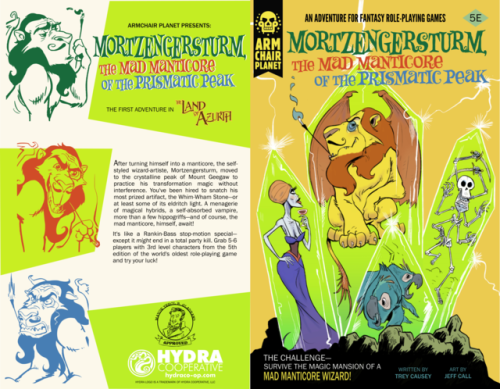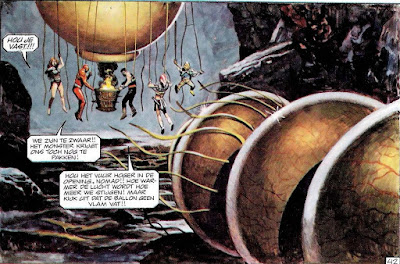In February of 2010, I had fantasy drugs on the mind. I'm happy to say that in the 7 plus years since this post originally appeared, a lot of fantastic intoxicants have appeared on blogs and OSR products.
"Not that we needed all that for the trip, but once you get into locked a serious drug collection, the tendency is to push it as far as you can."
- Raoul Duke, Fear and Loathing in Las Vegas
A couple of years ago, I was following a messageboard thread discussing drugs--intoxicants--in the context of fantasy gaming. It was prompted by White Wolf's Exalted
and the modern drugs like heroin and cocaine, apearing therein. One of the writer's involved with defended their choice to use those very modern drugs with those very modern names by saying that "made up" names for things were essentially lame/uncool, and that if a substance was familiar to player's under a certain name, that name ought to be used.
I disagreed in two ways. One, I think using too many words with modern connotations and origins can break the "mood" of fantasy. Such things are "amundisms," as Lin Carter would have it in his seminal exploration on world-building,
Imaginary Worlds (1973). Secondly, and most importantly, why should a world like Exalted's Creation, where fantastic creatures like the Beasts of Resplendent Liquids exist--which eat raw materials and excrete drugs--be saddled with the same old, boring drugs found in the real world? Surely, that's a failure of imagination.
Thankfully, many writers of fantastic fiction have not been so limited. Here are several examples of fantastic intoxicants which should serve to inspire interesting new substances for role-playing game characters to use (or misuse):
Black Lotus
In most of Howard's Conan stories, black lotus is a poison (though in "Hour of the Dragon" it's noted that its pollen causes "death-like sleep and monstrous dreams"), but the ancestors of the thoroughly stoned citizens of Xuthal have cultivated it until "instead of death, its juice induces dreams, gorgeous and fantastic." The effects appear to be similar to more mundane narcotics in terms of the heavy sleep and euphoria it induces with the added effect of generating vivid, pleasurable dreams. Find it in: "Xuthal of the Dusk" in
The Coming of Conan the Cimmerian.
Dreamshit
A mysterious, and powerful, new psychedelic drug on the streets of New Crobuzon in China Mieville's
Perdido Street Station. Dreamshit takes the form of brown, sticky pellets about the size of an olive that smell like burnt sugar. Eventually, it's discovered that dreamshit is the "milk" of the deadly, mind-devouring, slake-moths. Find it in:
Perdido Street Station by China Mieville.
Fledge
In Tim Lebbon's
Noreela, fledge is a commonly used (and abused) substance. Mined from deep underground the yellowish substance is put to many beneficial uses by the race of fledge miners for whom it provides sustenance, healing, and the ability to project their minds outside of their bodies. The fledge miners experience no ill-effects from their use, but do have withdrawal if they go without it. Taken to the surface, though, fledge degrades in quality--its mental-projection effects greatly diminish--and becomes highly addictive. Not that fledge mining is totally without dangers. There are rare, but powerful demons (the Nax) sometimes found near fledge veins. Lebbon also gives us another drug--rhellim--which enhances sexual stimulation, and comes from the livers of furbats. Find them in:
Dusk, and
Dawn by Tim Lebbon.
The Plutonian Drug
The Plutonian Drug appears in the Clark Ashton Smith story of the same name. Also called "plutonium"--though certainly not to be confused with the radioactive element of the same name--it's found on Pluto by the Cornell Brothers' 1990 expedition (I remember watching the intrepid explorers' return on live TV in 1994, don't you?). Its native form is crystalline, but it turns to a powder when exposed to earthly atmosphere. Ingestion of the drug causes the user to be able to perceive their own timeline for a relatively recent period as if it were a spatial dimension, allowing them to see a short distance into the future. Several other extraterrestrial drugs are mentioned in the same story. Find them in: "
The Plutonian Drug."
Shanga
Appearing in a couple of stories by Leigh Brackett, shanga certainly brings out the beast in its users. It isn't actually a drug, but a radiation produced by projector devices, the construction of which is a lost art. Users experience temporary atavism, allowing one to (as the quote goes) make oneself into a beast to get rid of the pain of being a man. The ancient projectors used a prism of an alien crystal rather than quartz, like the projectors found in the seeder parts of Martian trade-cities at the time of the stories. The crystals, the so-called Jewels of Shanga, produce a more potent effect leading to physical de-evolution, with longer exposure causing transformation to ever more remote evolutionary ancestral forms. Find it in: "Queen of the Martian Catacombs" (
The Secret of Sinharat), and "The Beast-Jewel of Mars."
There you go. Five substances for hours of simulated enjoyment. Turn on, tune in, play on.























































